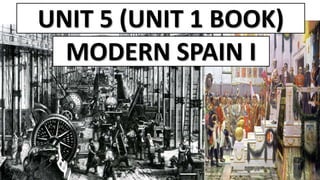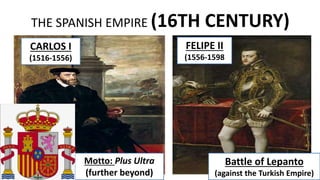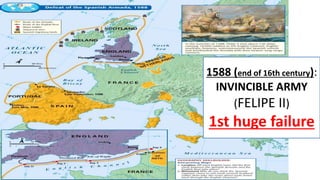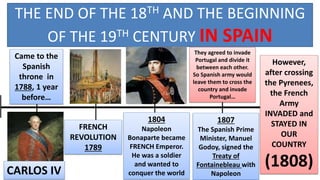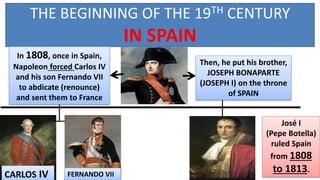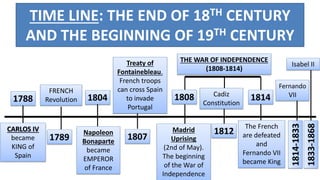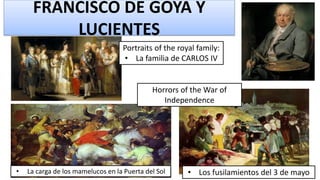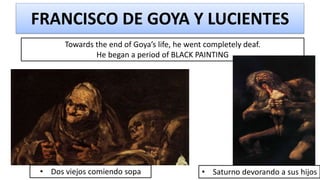Unit 5
- 1. UNIT 5 (UNIT 1 BOOK) MODERN SPAIN I
- 2. MIDDLE AGES PREHISTORY HISTORY PALEOLITIC NEOLITHIC EGYPT GREECE ANCIENT HISTORY HUNTERS WHO LIVED IN CAVES FIRST SETTLEMENTS (VILLAGES). AGRICULTURE BEGINS WRITING INVENTION (3500 BC) JESUS CHRIST IS BORN (YEAR 0 A.D.) THEFALLOFTHEROMANEMPIRE VISIGOTHS MUSLIMS (711.A.D) CHRISTIANS (722A.D.) DISCOVERYOFAMERIA Catholic Monarchs MODERN AGE 16THcentury: CarlosIandFelipeII 1492 A.D. ROME 17thcentury 18thcentury Baroque: GOLDEN AGE Renaissance INDUSTRIALREVOLUTIONAND FRENCHREVOLUTION(1789A.D.) BIG BANG 2-3 million years B.C. (humans appeared) 1789 A.D. 5TH century A.D.
- 3. THE SPANISH EMPIRE (16TH CENTURY) CARLOS I (1516-1556) FELIPE II (1556-1598 Motto: Plus Ultra (further beyond) Battle of Lepanto (against the Turkish Empire)
- 4. SPAIN AT THE END OF 16th CENTURY THE EMPIRE IN WHICH THE SUN NEVER SETS
- 5. 1588 (end of 16th century): INVINCIBLE ARMY (FELIPE II) 1st huge failure
- 6. 17th century (1600-1700 a.d.) 17th century (THE MODERN AGE) FELIPE III (EL PIADOSO): (1598 – 1621) LOSS OF INFLUENCE AND POWER IN EUROPE VALIDO: DUQUE DE LERMA FELIPE IV: (EL REY PASMADO O EL GRANDE): (1621-1665) VALIDO: CONDE-DUQUE DE OLIVARES Portugal Independent started in 1640 and finished in 1668. CARLOS II (EL HECHIZADO): (1665-1700) He couldn´t have any children. Habsburg dinasty endend in 1700
- 7. SPAIN IN THE 18TH CENTURY THE WAR OF SUCCESSION (1701 -1714) BOURBONS (FRANCE) HABSBURGS (AUSTRIA) •FELIPE V (NEW SPANISH KING): BOURBON DYNASTY (FRANCE) TREATY OF UTRECHT (PEACE) •GREAT BRITAIN RECEIVED GIBRALTAR • THE NETHERLANDS AND ITALIAN TERRITORIES WENT TO AUSTRIA consequences
- 8. 18TH CENTURY IN SPAIN (1700-1800 A.D.) 18TH CENTURY (THE MODERN AGE) FELIPE V: ABSOLUTE MONARCHY: unlimited power CARLOS III: the best mayor of Madrid Created hospitals, museums, sewage systems, fountains… In Madrid: Botanic Gardens, Puerta de Alcalá… CARLOS IV (1788-1808 A.D.) Goya Paintings
- 9. THE END OF 18TH CENTURY IN EUROPE INDUSTRIAL REVOLUTION (1760) FRENCH REVOLUTION (1789) IN GREAT BRITAIN People migrated from rural areas to cities looking for work in factories which had been developed thanks to new machinery and inventions IN FRANCE Political ideas changed moving from a absolute monarchy and giving more power to the people. Some years later, Napoleon Bonaparte would reach the French power.
- 10. INDUSTRIAL REVOLUTION JAMES WATT STEAM ENGINE Steam engines burned fossil fuels (COAL) to boil water, producing a new energy source: STEAM (vapour). This steam is used to move the wheels
- 11. Basic questions • Can you explain the French Revolution? • Which new ideas did the FRENCH REVOLUTION bring to the society? • Who was Napoleon Bonaparte? • Who was Carlos IV? • How did French troops invade Spain?
- 13. THE END OF THE 18TH AND THE BEGINNING OF THE 19TH CENTURY IN SPAIN CARLOS IV Came to the Spanish throne in 1788, 1 year before… FRENCH REVOLUTION 1789 1804 Napoleon Bonaparte became FRENCH Emperor. He was a soldier and wanted to conquer the world 1807 The Spanish Prime Minister, Manuel Godoy, signed the Treaty of Fontainebleau with Napoleon They agreed to invade Portugal and divide it between each other. So Spanish army would leave them to cross the country and invade Portugal… However, after crossing the Pyrenees, the French Army INVADED and STAYED IN OUR COUNTRY (1808)
- 14. TREATY OF FONTAINEABLEAU Initial idea
- 15. THE BEGINNING OF THE 19TH CENTURY IN SPAIN CARLOS IV In 1808, once in Spain, Napoleon forced Carlos IV and his son Fernando VII to abdicate (renounce) and sent them to France José I (Pepe Botella) ruled Spain from 1808 to 1813. FERNANDO VII Then, he put his brother, JOSEPH BONAPARTE (JOSEPH I) on the throne of SPAIN
- 16. THE BEGINNING OF THE 19TH CENTURY IN SPAIN: WAR OF INDEPENDENCE The French invasion caused an uprising (rebellion) in Madrid on 2nd of May 1808 and… In 1808, THE WAR OF INDEPENDENCE BEGAN! FRANCISCO DE GOYA Y LUCIENTES 1814 With the British help, the French were defeated in 1814, and Napoleon recognised Fernando VII as king of Spain (the absolute monarchy returned)
- 17. THE BEGINNING OF THE 19TH CENTURY IN SPAIN: the CONSTITUION OF 1812 In 1812, in CÁDIZ, the only place that was not under French rule, some politicians drew up (plan) and signed a Spanish Constitution It was the first Constitution in Spain and the most liberal Constitution at that time (freedom ideas): Equality for all Freedom of expression and press Constitutional Monarchy Right to vote to all men over 25
- 18. TIME LINE: THE END OF 18TH CENTURY AND THE BEGINNING OF 19TH CENTURY 1788 1789 1804 1807 CARLOS IV became KING of Spain FRENCH Revolution Napoleon Bonaparte became EMPEROR of France Treaty of Fontainebleau. French troops can cross Spain to invade Portugal THE WAR OF INDEPENDENCE (1808-1814) 1808 Madrid Uprising (2nd of May). The beginning of the War of Independence 1812 Cadiz Constitution 1814 The French are defeated and Fernando VII became King Fernando VII Isabel II 1814-1833 1833-1868
- 19. THE BEGINNING OF THE 19TH CENTURY The independence of the AMERICAN territories By 1825, Spain had lost all the territories, except for CUBA AND PUERTO RICO Colonies in the Americas took advantage of this political instability to become independent from Spain.
- 20. THE 19TH CENTURY: The reigns of Fernando VII and Isabel II FERNANDO VII (1814-1833) ABSOLUTISM (1814-1820) He declared Cadiz Constitution illegal in 1814 LIBERAL TRIENNIUM (1820-1823) He became an absolute monarch (many conficts) There were some military rebellions to get more freedom and restore the Cadiz Constitución but, in 1823, Fernando VII abolished again that Constitution OMINOUS DECADE (1823-1833) Last ten years of the reign of King Fernando VII, after the abolition of the Spanish Constitution, until his death in 1833. Period of repressions for liberals
- 21. THE 19TH CENTURY: The reigns of Fernando VII and Isabel II FELIPE VI LEONOR Isabel IIFERNANDO VII There was/is a law called “Salic law” (Ley Sálica) by which only male members of the royal family could be crowned (become KING)
- 22. 1814-1833 1833-1868 Isabel IIFERNANDO VII Before dieing, Fernando chose his eldest daughter Isabel as the next queen of Spain instead of his brother Carlos THE 19TH CENTURY: The reigns of Fernando VII and Isabel II I am Carlos, Fernando’s brother, the man! I have to be the Spanish king not my nice!
- 23. THE 19TH CENTURY: The reigns of Fernando VII and Isabel II 1833-1868 The beginning of her reign was marked by CIVIL WARS known as the CARLIST WARS Supporters of Isabel II Supporters of CARLOS (FERNANDO’S BROTHER) They won and during the Isabel reign… • Spain became a parliamentary monarchy (nowadays). • Political inestability (conflicts against the supporters of absolutism) • Isabel was forced to leave the country (exiled) in 1864 Isabel II
- 24. THE 19TH CENTURY: The reigns of Fernando VII and Isabel II Upper class • Nobility and rich factory owners and bankers called the upper bourgeoisie. Middle class • It was made up of people such as merchant, doctors, lawyers and small landowners Working class • It was made up of very low-paid agricutural workers. • Factory workers (badly paid and working in dangerous conditions) • They had very little chance to improve their social status.
- 25. FRANCISCO DE GOYA Y LUCIENTES Portraits of the royal family: • La familia de CARLOS IV Horrors of the War of Independence • La carga de los mamelucos en la Puerta del Sol • Los fusilamientos del 3 de mayo
- 26. FRANCISCO DE GOYA Y LUCIENTES Towards the end of Goya’s life, he went completely deaf. He began a period of BLACK PAINTING • Saturno devorando a sus hijos• Dos viejos comiendo sopa
